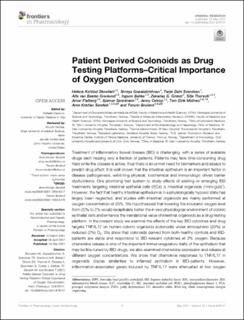| dc.contributor.author | Skovdahl, Helene Kolstad | |
| dc.contributor.author | Gopalakrishnan, Shreya | |
| dc.contributor.author | Svendsen, Tarjei Dahl | |
| dc.contributor.author | Granlund, Atle van Beelen | |
| dc.contributor.author | Bakke, Ingunn | |
| dc.contributor.author | Ginbot, Zekarias | |
| dc.contributor.author | Thorsvik, Silje | |
| dc.contributor.author | Flatberg, Arnar | |
| dc.contributor.author | Sporsheim, Bjørnar | |
| dc.contributor.author | Ostrop, Jenny | |
| dc.contributor.author | Mollnes, Tom Eirik | |
| dc.contributor.author | Sandvik, Arne Kristian | |
| dc.contributor.author | Bruland, Torunn | |
| dc.date.accessioned | 2021-10-26T08:12:34Z | |
| dc.date.available | 2021-10-26T08:12:34Z | |
| dc.date.created | 2021-06-03T13:04:39Z | |
| dc.date.issued | 2021 | |
| dc.identifier.citation | Frontiers in Pharmacology. 2021, 12:679741 1-15. | en_US |
| dc.identifier.issn | 1663-9812 | |
| dc.identifier.uri | https://hdl.handle.net/11250/2825556 | |
| dc.description.abstract | Treatment of inflammatory bowel disease (IBD) is challenging, with a series of available drugs each helping only a fraction of patients. Patients may face time-consuming drug trials while the disease is active, thus there is an unmet need for biomarkers and assays to predict drug effect. It is well known that the intestinal epithelium is an important factor in disease pathogenesis, exhibiting physical, biochemical and immunologic driven barrier dysfunctions. One promising test system to study effects of existing or emerging IBD treatments targeting intestinal epithelial cells (IECs) is intestinal organoids (“mini-guts”). However, the fact that healthy intestinal epithelium is in a physiologically hypoxic state has largely been neglected, and studies with intestinal organoids are mainly performed at oxygen concentration of 20%. We hypothesized that lowering the incubator oxygen level from 20% to 2% would recapitulate better the in vivo physiological environment of colonic epithelial cells and enhance the translational value of intestinal organoids as a drug testing platform. In the present study we examine the effects of the key IBD cytokines and drug targets TNF/IL17 on human colonic organoids (colonoids) under atmospheric (20%) or reduced (2%) O2. We show that colonoids derived from both healthy controls and IBD-patients are viable and responsive to IBD-relevant cytokines at 2% oxygen. Because chemokine release is one of the important immunoregulatory traits of the epithelium that may be fine-tuned by IBD-drugs, we also examined chemokine expression and release at different oxygen concentrations. We show that chemokine responses to TNF/IL17 in organoids display similarities to inflamed epithelium in IBD-patients. However, inflammation-associated genes induced by TNF/IL17 were attenuated at low oxygen concentration. We detected substantial oxygen-dependent differences in gene expression in untreated as well as TNF/IL17 treated colonoids in all donors. Further, for some of the IBD-relevant cytokines differences between colonoids from healthy controls and IBD patients were more pronounced in 2% O2 than 20% O2. Our results strongly indicate that an oxygen concentration similar to the in vivo epithelial cell environment is of essence in experimental pharmacology. | en_US |
| dc.language.iso | eng | en_US |
| dc.publisher | Frontiers | en_US |
| dc.rights | Navngivelse 4.0 Internasjonal | * |
| dc.rights.uri | http://creativecommons.org/licenses/by/4.0/deed.no | * |
| dc.title | Patient derived colonoids as drug testing platforms-Critical importance of oxygen concentration | en_US |
| dc.type | Peer reviewed | en_US |
| dc.type | Journal article | en_US |
| dc.description.version | publishedVersion | en_US |
| dc.source.pagenumber | 1-15 | en_US |
| dc.source.volume | 12:679741 | en_US |
| dc.source.journal | Frontiers in Pharmacology | en_US |
| dc.identifier.doi | 10.3389/fphar.2021.679741 | |
| dc.identifier.cristin | 1913559 | |
| dc.relation.project | Samarbeidsorganet mellom Helse Midt-Norge og NTNU: 90285400 | en_US |
| dc.relation.project | Samarbeidsorganet mellom Helse Midt-Norge og NTNU: 90284800 | en_US |
| cristin.ispublished | true | |
| cristin.fulltext | original | |
| cristin.qualitycode | 1 | |

